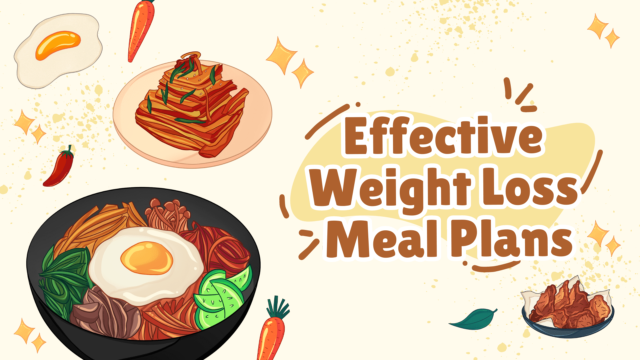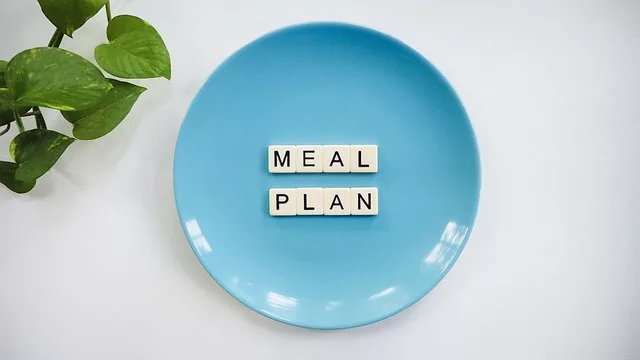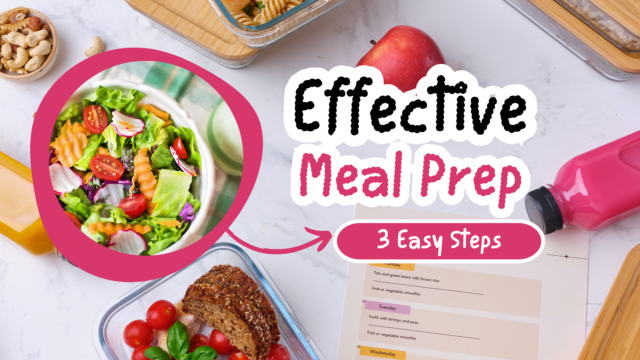Effective weight loss meal plans are essential for anyone looking to shed some pounds. Meal prep for weight loss is a fantastic way to stay on track and make sure you are eating healthy, nutritious meals that will help you reach your weight loss goals. With so many different meal plans and options available, it can be overwhelming to know where to start.

One crucial factor to consider when choosing a weight loss meal plan is affordability. Many people assume that healthy eating is expensive, but with the right planning and preparation, it can be quite affordable. There are a lot of budget-friendly meal plans available that provide all the necessary nutrients and help you lose weight without breaking the bank.
Another important aspect of a successful weight loss meal plan is incorporating the best foods for weight loss. These foods are typically low in calories, high in fibre and protein, and packed with nutrients that help you feel full and satisfied. By including these foods in your meal plan, you can ensure that you are getting the most out of your meals and staying on track with your weight loss goals.
Fundamentals of Weight Loss Meal Plans

When it comes to weight loss, diet is an essential factor. A weight loss meal plan is a well-structured diet that helps to achieve the desired weight loss goals. Here are the fundamental aspects of a weight loss meal plan.
Understanding Caloric Deficit
Caloric deficit is a state where the body burns more calories than it consumes. It is the foundation of weight loss. To lose weight, one must create a caloric deficit by consuming fewer calories than the body burns. A weight loss meal plan should take into account the individual’s basal metabolic rate, physical activity level, and weight loss goals to determine the appropriate caloric intake.
Macronutrient Balance
Macronutrients are the three main nutrients that the body needs in substantial amounts: carbohydrates, proteins, and fats. A weight loss meal plan should have a balanced macronutrient ratio to ensure that the body gets all the necessary nutrients while still creating a caloric deficit. Generally, a weight loss meal plan should have a higher protein intake to promote satiety and muscle retention.
Importance of Nutrient Density
Nutrient density refers to the amount of nutrients in a food per calorie. A weight loss meal plan should consist of nutrient-dense foods that provide the body with essential vitamins, minerals, and fibre. Nutrient-dense foods are low in calories, which helps to create a caloric deficit. Examples of nutrient-dense foods include vegetables, fruits, lean proteins, and whole grains.
In summary, a weight loss meal plan should create a caloric deficit by balancing macronutrient ratios and including nutrient-dense foods. By following a well-structured weight loss meal plan, individuals can achieve their weight loss goals in a healthy and sustainable way.
Strategies for Meal Prep

When it comes to losing weight, meal prep is one of the most effective strategies. By planning and preparing meals in advance, individuals can ensure that they are eating healthy and nutrient-rich foods while avoiding the temptation of unhealthy snacks and takeout. Here are a few tips for effective meal prep for weight loss.
Planning Your Meals
The first step in effective meal prep is planning your meals. This involves deciding what foods you will eat for each meal and snack and ensuring that you have the necessary ingredients on hand. To make this process easier, consider creating a meal plan for the week ahead. This will help you stay on track and avoid the temptation to order takeout or grab unhealthy snacks.
When planning your meals, be sure to include a variety of nutrient-rich foods such as fruits, vegetables, lean proteins, and whole grains. This will not only help you lose weight but also provide your body with the nutrients it needs to function properly.
Time-Saving Tips
One of the biggest challenges of meal prep is finding the time to do it. To make the process easier and more efficient, consider the following time-saving tips:
- Cook in bulk: Cook large batches of food and freeze them in individual portions. This will save you time and ensure that you always have healthy meals on hand.
- Use a slow cooker: Slow cookers are a fantastic way to prepare healthy meals with minimal effort. Simply add your ingredients to the slow cooker in the morning and let it cook all day.
- Prep ingredients in advance: Chop vegetables, cook rice, and prepare other ingredients in advance to save time during the week.
Storing and Reheating
Proper storage and reheating are essential for maintaining the quality and safety of your meals. When storing your meals, be sure to use airtight containers and store them in the refrigerator or freezer. When reheating, be sure to follow proper food safety guidelines to avoid the risk of foodborne illness.
In conclusion, meal prep is an effective strategy for weight loss. By planning your meals, using time-saving tips, and storing and reheating your meals, you can ensure that you are eating healthy and nutrient-rich foods while avoiding the temptation of unhealthy snacks and takeout.
Affordable Weight Loss Meal Plans

When it comes to weight loss, many people believe that they must spend a lot of money on expensive diet plans and supplements. However, this is not necessarily the case. There are many affordable weight loss meal plans that can help you achieve your goals without breaking the bank.
Shopping on a Budget
One of the keys to creating an affordable weight loss meal plan is to shop on a budget. This means looking for deals and discounts on healthy foods, as well as buying in bulk. A few tips for shopping on a budget include:
- Look for sales and discounts on healthy foods, such as fresh produce, lean proteins, and whole grains.
- Buy in bulk when possible, especially for items like rice, beans, and nuts.
- Plan meals around ingredients that are on sale or in season.
- Consider buying frozen fruits and vegetables, which can be just as nutritious as fresh but are often less expensive.
Using Whole Foods Effectively
Another way to create an affordable weight loss meal plan is to focus on whole foods. Whole foods are foods minimal processing and contain no added sugars or artificial ingredients. Some examples of whole foods include:
- Fresh fruits and vegetables
- Lean proteins, such as chicken, fish, and tofu
- Whole grains, such as brown rice and quinoa
- Nuts and seeds.
By using whole foods effectively, you can create healthy and affordable meals that will help you lose weight. A few tips for using whole foods effectively include:
- Choose recipes that feature whole foods as the main ingredients.
- Use herbs and spices to add flavour to your meals instead of relying on high-calorie sauces and dressings.
- Experiment with different cooking methods, such as grilling, roasting, and sautéing, to bring out the natural Flavors of whole foods.
Reducing Food Waste
Finally, reducing food waste is another important aspect of creating an affordable weight loss meal plan. Food waste not only wastes money but also contributes to environmental problems. Some tips for reducing food waste include:
- Plan meals and snacks in advance to avoid overbuying or buying items that will go to waste.
- Use leftovers creatively, such as turning roasted vegetables into a frittata or using leftover chicken in a salad.
- Freeze leftover fruits and vegetables to use in smoothies or other recipes later on.
By following these tips, you can create an affordable weight loss meal plan that is both healthy and delicious.
Optimal Foods for Weight Loss

When it comes to weight loss, choosing the right foods is crucial. The following subsections highlight some of the best foods for weight loss meal plans.
Vegetables and Fruits
Vegetables and fruits are low in calories and high in nutrients, making them an ideal choice for weight loss meal plans. They are also rich in fibre, which helps to keep you feeling full and satisfied. Some options include:
- Leafy greens like spinach, kale, and collard greens
- Cruciferous vegetables like broccoli, cauliflower, and Brussels sprouts
- Berries like strawberries, raspberries, and blueberries
- Citrus fruits like oranges and grapefruits
- Apples, pears, and other high-fiber fruits
Lean Proteins
Protein is an essential nutrient for weight loss because it helps to build and maintain muscle mass, which can boost your metabolism and burn more calories. Lean proteins are low in fat and calories, making them an ideal choice for weight loss meal plans. Some of the best options include:
- Skinless chicken breast
- Turkey breast
- Fish like salmon, tuna, and cod
- Lean beef like sirloin or tenderloin
- Plant-based proteins like tofu, tempeh, and legumes
Whole Grains and Fiber
Whole grains are an excellent source of fiber, which can help to keep you feeling full and satisfied. They are also rich in nutrients like vitamins and minerals. Some great options include:
- Whole wheat bread and pasta
- Brown rice
- Quinoa
- Oats
- Barley
Incorporating these optimal foods into your weight loss meal plan can help you achieve your goals in a healthy and sustainable way.
Conclusion
Achieving your weight loss goals doesn’t have to be a financial burden. By embracing affordable and effective meal plans, you can nourish your body with nutrient-dense foods while keeping your budget in check. From planning meals ahead to incorporating versatile, low-cost ingredients, these strategies ensure you stay on track without sacrificing flavor or satisfaction. Remember, the journey to a healthier you is as much about smart choices and consistency as it is about discipline and dedication. Start today, make every meal count, and watch as your efforts transform your health and well-being.
